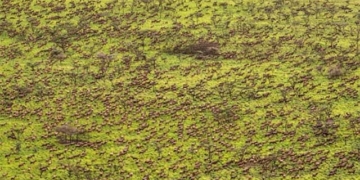 Freckles do not affect health but can easily be confused with more serious conditions such as malignant moles or skin cancer. Therefore, if you have one or more pigmented spots and are unsure if they are freckles, it is advisable to see a dermatologist for an examination.
Freckles do not affect health but can easily be confused with more serious conditions such as malignant moles or skin cancer. Therefore, if you have one or more pigmented spots and are unsure if they are freckles, it is advisable to see a dermatologist for an examination.
Freckles are a minor skin imperfection, primarily related to the growth of pigment in the basal and dermal layers. They appear as small, round, flat brown spots with a diameter of less than 0.5 cm, commonly found on the face, neck, shoulders, and backs of the hands after sun exposure.
Freckles are often seen in individuals with fair, thin, and smooth skin; they can be hereditary. As one ages, freckles tend to darken. The condition tends to increase in summer and decrease in winter. Freckles only affect aesthetics and do not harm health.
Freckles become more pronounced when the body is weak and fade when the body is healthy. Therefore, to minimize the aesthetic impact of freckles, the main issue is to enhance overall health. Freckles can appear in various colors: red, yellow, dark brown, light brown, brown, or black; they are always darker than the surrounding skin due to melanin deposits.
It is important to distinguish freckles from moles—pigmented spots (black) that can occur at any age and appear anywhere on the body. Freckles can also be easily confused with melasma—brown spots or patches with a diameter of several centimeters, commonly appearing on the cheeks, temples, and forehead of pregnant women, menopausal women, or those taking birth control pills. Additionally, it is necessary to differentiate freckles from the following conditions:
Malignant Melanocytic Nevi: This is a rare condition that usually occurs on the face of older individuals with a history of significant sun exposure. If left untreated for many years, this condition can progress to malignant skin cancer.
Melanoma: A very dangerous form of skin cancer that can appear in young people. Approximately 40-50% of melanomas develop from moles. However, compared to freckles, melanomas tend to be larger, darker, and lack the specific color patterns of regular freckles.
Basal Cell Carcinoma: The most common form of skin cancer. It often appears red or shiny, but it can occasionally turn brown, leading to confusion with freckles.
There are two types of freckles
Freckle Spots: These are flat red or light brown spots that appear during sunny summer months and fade or disappear in winter. This type of freckle is commonly seen in individuals with light skin, and in some families, they may be hereditary. Protection during sun exposure is essential to prevent the appearance of freckle spots.
Birthmarks: Children may develop a dark brown, brown, or black spot that tends to be darker than freckle spots and does not fade during winter. This type of spot is considered a simple mole. The hereditary nature of these moles is rare, and they usually appear as isolated spots.
Freckles can appear at any time; they are not a sign of aging. Occasionally, moles in older individuals may turn brown and develop rough, dry patches known as seborrheic keratosis. Seborrheic keratosis appears waxy and may occur in the same areas as freckles, but the cause is not sunlight exposure; they can appear in covered areas as well.
Treatment and Prevention
Freckles tend to progress alongside sun-sensitive skin cancer. They also serve as a warning sign for individuals with skin prone to sun damage and skin cancer.
Chemicals can be used to lighten freckles (such as hydrogen peroxide, mercury), and this method can be done at home. In some cases, laser treatment may be used. If freckles become numerous and dark, treatment may require certain medications or cosmetics under the clear guidance of a specialist.
However, chemical treatment methods such as topical solutions can only lighten the color and cannot prevent the appearance of new freckles. Methods such as electrosurgery, laser therapy, or cryotherapy with liquid nitrogen can remove freckles, but if not done carefully, they can easily leave behind dark scars or hypopigmented scars, reducing aesthetic appeal.
Therefore, prevention is always better than treatment after freckles appear. Individuals with a hereditary tendency to freckles should cover up whenever appropriate and minimize sun exposure. This practice helps prevent the development of freckles and, more importantly, reduces the risk of skin cancer.
Sun protection should include wearing wide-brimmed hats, gloves, and using sunscreen with an SPF greater than 15 (applying it to exposed skin 20-30 minutes before sun exposure), avoiding outdoor activities from 10 AM to 2 PM. Additionally, skin whitening creams containing 2% hydroquinone or vitamin A can be used in the evenings before bedtime.

















































